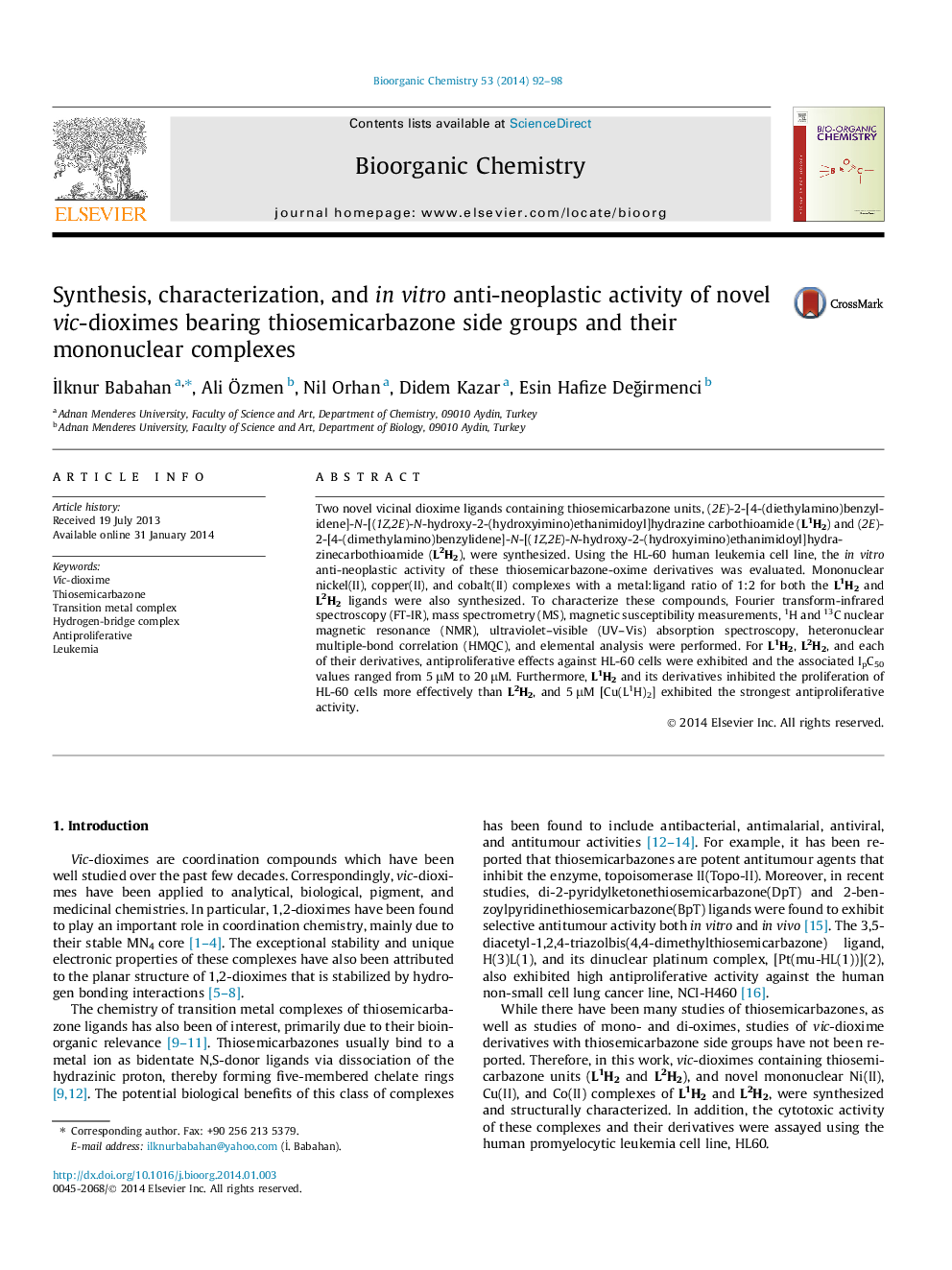| Article ID | Journal | Published Year | Pages | File Type |
|---|---|---|---|---|
| 1355636 | Bioorganic Chemistry | 2014 | 7 Pages |
•Preparation of novel ligands.•Preparation of novel complexes.•Characterization of ligands and complexes.•Using 1H NMR, 13C NMR, MS, infrared and, UV–Vis spectroscopy.•Antiproliferative activity.
Two novel vicinal dioxime ligands containing thiosemicarbazone units, (2E)-2-[4-(diethylamino)benzylidene]-N-[(1Z,2E)-N-hydroxy-2-(hydroxyimino)ethanimidoyl]hydrazine carbothioamide (L1H2) and (2E)-2-[4-(dimethylamino)benzylidene]-N-[(1Z,2E)-N-hydroxy-2-(hydroxyimino)ethanimidoyl]hydrazinecarbothioamide (L2H2), were synthesized. Using the HL-60 human leukemia cell line, the in vitro anti-neoplastic activity of these thiosemicarbazone-oxime derivatives was evaluated. Mononuclear nickel(II), copper(II), and cobalt(II) complexes with a metal:ligand ratio of 1:2 for both the L1H2 and L2H2 ligands were also synthesized. To characterize these compounds, Fourier transform-infrared spectroscopy (FT-IR), mass spectrometry (MS), magnetic susceptibility measurements, 1H and 13C nuclear magnetic resonance (NMR), ultraviolet–visible (UV–Vis) absorption spectroscopy, heteronuclear multiple-bond correlation (HMQC), and elemental analysis were performed. For L1H2, L2H2, and each of their derivatives, antiproliferative effects against HL-60 cells were exhibited and the associated IpC50 values ranged from 5 μM to 20 μM. Furthermore, L1H2 and its derivatives inhibited the proliferation of HL-60 cells more effectively than L2H2, and 5 μM [Cu(L1H)2] exhibited the strongest antiproliferative activity.
Graphical abstractIn this work, novel vic-dioxime ligands (L1H2 and L2H2) containing thiosemicarbazone moieties and their complexes with Ni(II), Cu(II) and Co(II) ions were synthesized and characterized using 1H NMR, 13C NMR, HMQC, MS, infrared and, UV–Vis spectroscopy, elemental analysis, and magnetic susceptibility measurements as well as their antiproliferative activities were evaluated. In this study we have determined the cytotoxic activity of novel Ni(II), Cu(II) and Co(II) complexes of derivatives of thiosemicarbazone glyoxime (L1H2 and L2H2) at first time by human cell culture. For determining the antiproliferative effect on neoplastic cells, HL60 (Human promyelocytic leukemia cells) cell line was cultured. L1H2 and L2H2 and their derivatives can be described as potent anti-cancer agents due to their antiproliferative effects with an IpC50 between 5 and 20 μM concentrations. L1H2 and its derivatives have inhibited the HL-60 cells proliferation more from L2H2. The strongest antiproliferative activity was determined with the Cu complex of [Cu(L1H)2] at 5 μM.Figure optionsDownload full-size imageDownload as PowerPoint slide
